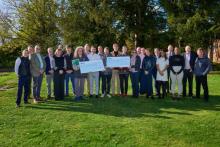The winners of the International Quarry Life Award have been honoured at a festive award ceremony held in Prague, Czech Republic.
The Quarry Life Award was established by
“This second edition of the Quarry Life Award was a resounding success,” Daniel Gauthier, member of the managing board of HeidelbergCement, said in his welcome address.
“The Quarry Life Award has generated great enthusiasm among researchers, students, environmental associations, and our own employees. The competition and research projects allow HeidelbergCement to improve its biodiversity management practices as well as share best practice examples with the public. The competition clearly augments our collective knowledge about the biological value of mineral extraction sites.”
The jury bestowed the 2014 Quarry Life Award on the following projects:
The Grand Prize
“A comprehensive inventory of herpetofauna at the Górażdże limestone quarry” by Edyta Turniak, NATRIX Herpetological Association, Poland.
The researchers completed a comprehensive inventory of the reptiles and amphibians living in the Górażdże limestone quarry. They found out that the high degree of biodiversity at the quarry is mainly due to the presence of many amphibian and reptile species. As a consequence, they developed a list of recommended land reclamation practices.
Winner in the category Biodiversity and Education
Youth view at quarry nature by Diana Prischepenko, Russia.
The main goal of the project was to improve youth awareness of biodiversity in quarries through environmental education and raising public awareness. The local community was actively involved in the research project and in the development of a board game based on ecology issues.
Winner in the category Innovation and Biodiversity
The use of vermicompost as treatment for topsoil to restore biodiversity by Kwasi Boadu Ntiamoah, Ghana
This project aims at converting organic food waste, through vermicomposting, into compost that has the power to restore the fertility of the topsoil in a quarry, and thereby promote biodiversity.
Winners in the category Biodiversity Enhancement
Research of the biodiversity at the Tovacov lakes by Jan Ševčík, Czech Republic.
The Tovacov lakes offer habitats for many (protected) plant and animal species. To improve the function and quality of these biotopes, and to increase their current biological value, a set of 17 recommendations were developed.
The feasibility of biodiversity enhancements in woodland ground flora around Whatley Quarry by David Watson, Bath Spa University, UK.
This project examined the feasibility of enhancing woodland ground flora in woodland plantings at Whatley Quarry, in order to improve their biodiversity value.
Winner in the category Raising Public Awareness
Community engagement framework by Sophie Malkin, Australia.
This project provided quarry managers with practical and flexible step-by-step guidance on how to promote effective local community engagement based on best-practice techniques and successful global examples.
Winner in the category Student Project
Design and development of suitable spawning grounds for the protection of native amphibians by Jürgen Reusch, Jessen Grammar School, Germany
The project studied the potential spawning waters of native amphibian species at the Steinsdorf gravel pit, and addressed demands to preserve biological diversity coupled with the objectives of restoration.








